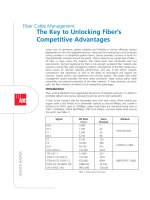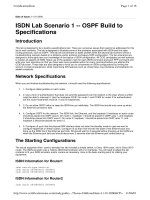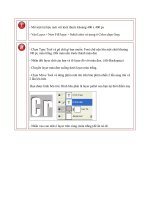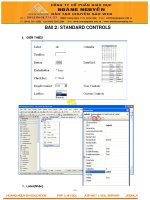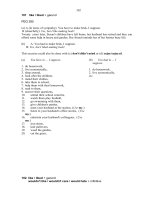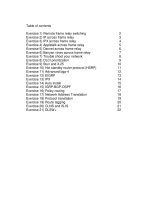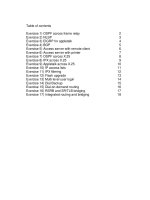Tài liệu C++ Lab 2 Sending the output to a printfile Data Types: Chapter 2 ppt
Bạn đang xem bản rút gọn của tài liệu. Xem và tải ngay bản đầy đủ của tài liệu tại đây (101.25 KB, 13 trang )
CHAPTER 2B
PROGRAMMIG TIP
After the first laboratory assignment several
students came to my office and asked questions
that were very similar. Thus, this addendum to
Chapter 1 was written. When a program is
assigned to you the first thing you should do is to
understand the problem. Even though you may
think that the assignment is very easy and you
can do it at the last minute, most of the time this
is not the case. Therefore, I require you to solve
the problem assigned to you with "paper and
pencil" first. If you approach me or the graduate
assistant for help with a programming problem,
you will be asked show this handwritten work
first. If you do not have it, we will not help you
with the coding. We will still help you to
understand the problem.
Once you understood the problem, figure out all
the functions and variables needed to write the
program. Make a structure chart and show the
data flow. Next, write the psuedocode for each of
the modules. A structure chart tells you what to
do, a psuedocode tells you how to do it. I will
cover this in class at great detail.
Here is an example of a programming
assignment.
Write a program to determine how
many quarter rolls, dime rolls, nickel
rolls and penny rolls in a given amount
of dollars.
Let us understand this problem.
What are the known information about
this programming assignemnt?
There are ten dollars in a quarter roll.
There are five dollars in a dime roll.
There are two dollars in a nickel roll.
And there are two penny rolls in a
dollar.
The amount may vary each time you
run the program. For this example let
us assume the amount is 38 dollars.
Quarter rolls may be obtained by doing
integer division 38/10. Integer division
gives you only the integer portion of
the result. >3 quarter rolls.
Remainder is 38-30, which is 8. You
can get the remainder by doing the
modulus operation.
Dime rolls may be obtained by doing
integer division 8/5 > 1 dime
roll.
The remainder is 8-5, whch is 3.
Nickel rolls may be obtained by doing
integer division 3/2 > 1 nickel
roll.
The remainder may be obtained by
doing the modulus operation, which
will give a remainder of 1.
There are two rolls of pennies in a
dollar > 2 penny rolls.
Refining this will give you the
following:
get dollars
read dollars from the
keyboard
calculate quarter rolls and remainder
quarter_rolls = dollars /
10
remainder = dollars % 10
calculate dime rolls and remainder
dime_rolls = remainder /
5
remainder = remainder %
5
calculate nickel rolls and remainder
nickel_rolls = remainder /
2
remainder = remainder %
2
calculate penny rolls
penny_rolls = remainder *
2
After doing all the above, go to the computer lab,
launch the Visual C++ or whatever compiler you
like. Many of you write the entire program in
then spend hours trying to debug it. A better
practice is to write smaller portions first.
Write a shell of the program as follows, save it to
the appropriate subdirectory. If you are using the
campus computer, save to
c:\temp\yourfilename.cpp. Replace yourfilename
with whatever name you want to call it. Compile
the program and make sure that there no errors.
Remember to copy the yourfilename.cpp to
your floppy disk before logging out of the
computer. Once you logout all your work will be
erased. You can copy the file by either dragging
the file from the C: drive to A: drive or copying
from C: and pasting to A:.
Sample program shell.
/******************************************
Put all your comments here
*****************************************/
#include <iostream>
using namespace std;
int main()
{
return (0);
}
If no errors occurred in the above program, begin to write
the source code. If you are not an experienced typist or a
programmer, I suggest that you compile the program after
every few lines. Make sure there are no errors. You are
allowed to have warnings, but no errors. Correct the
errors before continuing.
Program 2B_1.
/********************************************************
Calculate how many Quarter Rolls, Dime Rolls
Nickel Rolls and Penny rolls in given dollar amount.
By Dr. John Abraham
Created for 1370 students
**********************************************************/
#include <iostream>
using namespace std;
int main()
{
int dollar, quarterR, dimeR, nickelR, pennyR, remainder;
//prompt and read dollar
cout << "Enter amount of dollars to change > ";
cin >> dollar;
//find quarter rolls
quarterR = dollar / 10;
remainder = dollar % 10;
//find dime rolls
dimeR = remainder / 5;
remainder = remainder % 5;
//find nickel rolls
nickelR = remainder / 2;
remainder = remainder %2;
//find penny rolls
pennyR = remainder *2;
//display results
cout << "amount entered > " << dollar << "\n";
cout << "quarter rolls > " << quarterR << "\n";
cout << "dime rolls > " << dimeR << "\n";
cout << "nickel rolls > " << nickelR << "\n";
cout << "penny rolls > " << pennyR << "\n";
return(0);
}
Program Run OneB_1
Enter amount of dollars to change > 38
amount entered > 38
quarter rolls > 3
dime rolls > 1
nickel rolls > 1
penny rolls > 2
Press any key to continue
Here is a description of the program line by line.
int main()
Every program must have a main function. A program begins
executing with the main function. Main returns an integer value to
DOS.
{
The left bracket indicates the beginning of the main.
int dollar, quarterR, dimeR, nickelR, pennyR, remainder;
Variables that are used in the main are declared. There are six
variables of type integer. These variable names (identifiers) stand for
memory locations. In each of these memory locations, only whole
numbers within the range of -32768 to 32767 can be stored.
//prompt and read dollar
cout << "Enter amount of dollars to change > ";
Displays the prompt to the user.
cin >> dollar;
Waits for the user to type in a value at the keyboard. When a value is
entered, that value is stored in the memory location referred to by
dollar.
//find quarter rolls
quarterR = dollar / 10;
Result of this integer division is stored in the variable called
quarterB.
remainder = dollar % 10;
Result of this modulus operation is stored in the memory location
referred to by remainder.
//find dime rolls
dimeR = remainder / 5;
remainder = remainder % 5;
//find nickel rolls
nickelR = remainder / 2;
remainder = remainder %2;
//find penny rolls
pennyR = remainder *2;
//display results
cout << "amount entered > " << dollar << "\n";
cout << "quarter rolls > " << quarterR << "\n";
cout << "dime rolls > " << dimeR << "\n";
cout << "nickel rolls > " << nickelR << "\n";
cout << "penny rolls > " << pennyR << "\n";
return(0);
}
This program only prints to the monitor. We want the program run to
be saved in a file. The following program shows the necessary lines
required to do it.
Program 2B_2.
/********************************************************
Calculate how many Quarter Rolls, Dime Rolls
Nickel Rolls and Penny rolls in given dollar amount.
By Dr. John Abraham
Created for 1370 students
**********************************************************/
#include <iostream>
#include <fstream>
using namespace std;
int main()
{
//file routines
ofstream outfile;
outfile.open("a:OneB_1.txt");
int dollar, quarterR, dimeR, nickelR, pennyR, remainder;
//prompt and read dollar
cout << "Enter amount of dollars to change > ";
cin >> dollar;
outfile << "Enter amount of dollars to change > " << dollar
<< "\n";
//find quarter rolls
quarterR = dollar / 10;
remainder = dollar % 10;
//find dime rolls
dimeR = remainder / 5;
remainder = remainder % 5;
//find nickel rolls
nickelR = remainder / 2;
remainder = remainder %2;
//find penny rolls
pennyR = remainder *2;
//display results
cout << "amount entered > " << dollar << "\n";
cout << "quarter rolls > " << quarterR << "\n";
cout << "dime rolls > " << dimeR << "\n";
cout << "nickel rolls > " << nickelR << "\n";
cout << "penny rolls > " << pennyR << "\n";
outfile << "amount entered > " << dollar << "\n";
outfile << "quarter rolls > " << quarterR << "\n";
outfile << "dime rolls > " << dimeR << "\n";
outfile << "nickel rolls > " << nickelR << "\n";
outfile << "penny rolls > " << pennyR << "\n";
outfile.close();
return(0);
}
Once this program is run a file is created in the floppy disk drive.
I opened the file that was created (2B_2.txt) using MS Word.
Here is the output:
Enter amount of dollars to change > 44
amount entered > 44
quarter rolls > 4
dime rolls > 0
nickel rolls > 2
penny rolls > 0
